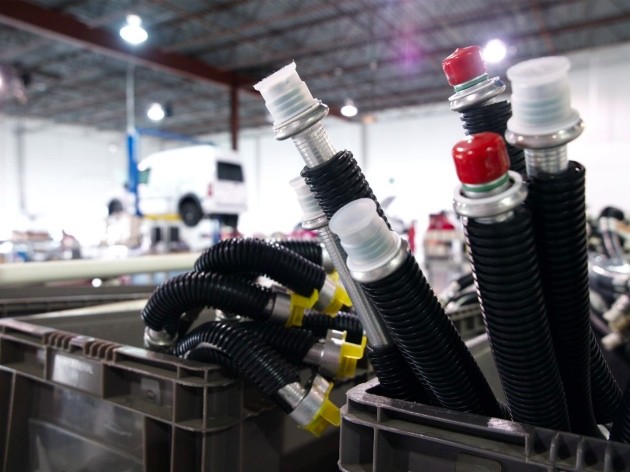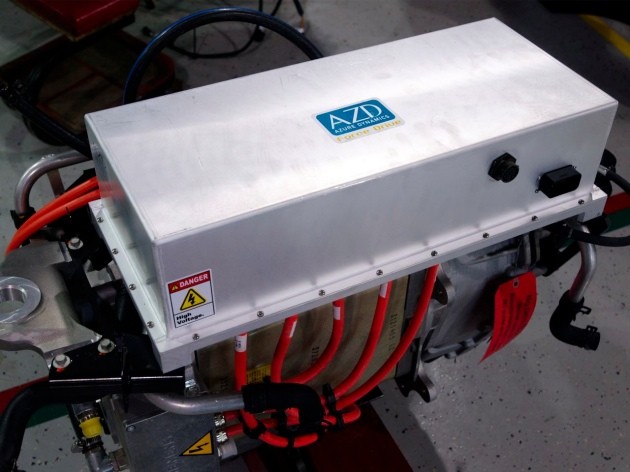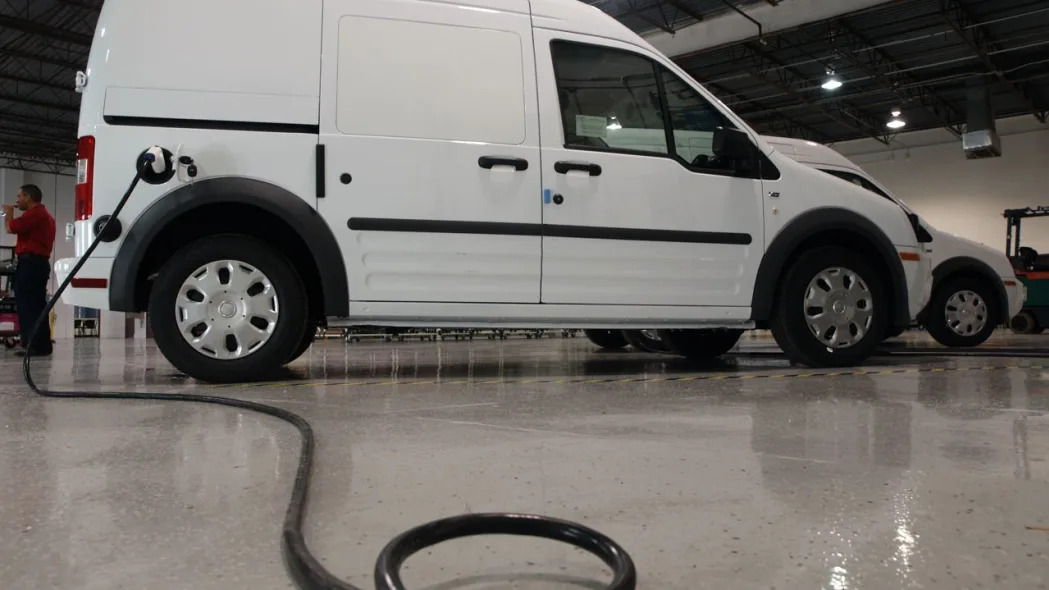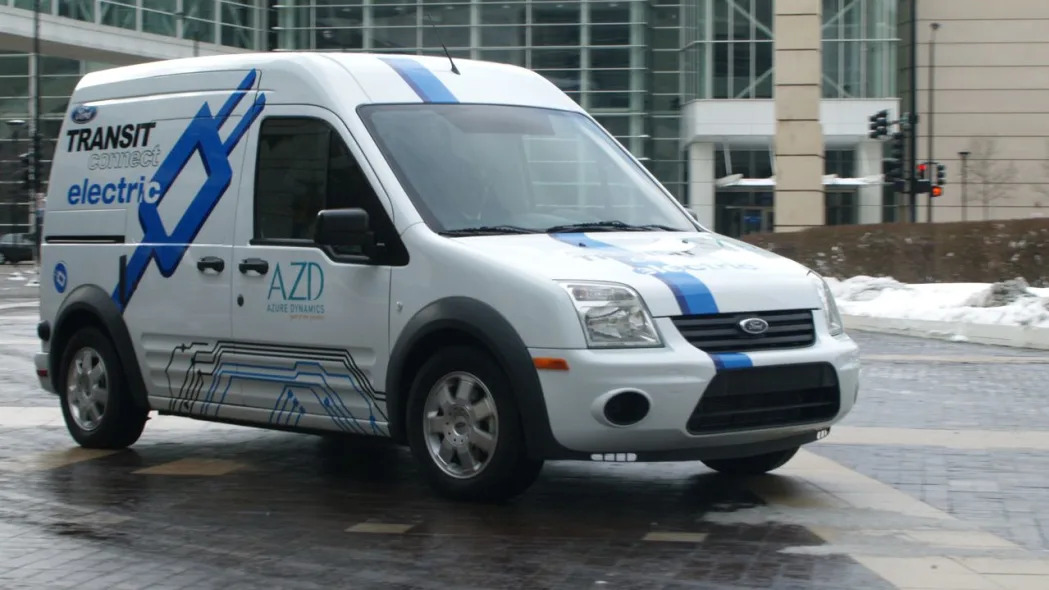Ford Transit Connect Electric van – Click above for high-res image gallery
The Ford Transit Connect Electric. That's not a short, snappy name. Sure, it's mostly accurate and it follows the Blue Oval's naming structure for plug-in vehicles (see also: Ford Focus Electric), but it's a mouthful. It's just "mostly" accurate because this is a only partly a Ford vehicle. The Transit Connect Electric's "manufacturer of record" is Azure Dynamics, which worked with Ford (and Johnson Controls-Saft and AM General) on the plug-in electric delivery van that officially went into production today in Livonia, MI, a city near/suburb of Detroit. How much did Ford have to do to get the electric van into production – aside from making the liquid-fueled Transit Connect in the first place? We don't know for sure, but there were only five Ford employees who worked full-time on the Transit Connect Electric program.
We visited the incredibly clean AM General facility this morning to learn a bit more about Ford's first foray into all-electric vehicles since the Ranger EV. Read on for the fullest and latest on the Transit Connect Electric.
Photos copyright ©2010 Sebastian Blanco / Weblogs, Inc.
Rough, fast road to production
All the Ford representatives who were involved with the Transit Connect Electric – full time or part time – must have been happy today, because they were all under the gun, a gun of their own making. Back in February 2009, Ford promised it would have the Transit Connect Electric ready by the end of 2010. At the time, Ford's partner was Smith Electric Vehicles, but Smith ended up being more interested in electrifying larger vehicles, and the two amicably companies parted ways. Azure Dynamics stepped in, and the rush was on to meet Ford's deadline. The first phase of engineering development modeling and early builds happened in December 2009. Starting in May 2010, the team built fifteen test vehicles. The partners kept up the frantic pace into the fall, when they came to AM General. Rick Smith, president of commercial business for AM General said as he opened the ceremonies today that, "90 days ago, this was a dirty little facility. This quick, flash and bang type of effort is what we do here at AM General." The message from everyone was that all parties worked well together, but the Transit Connect Electric's family tree is broad and has deep roots.

Made in Michigan – with imported parts
Final assembly for the Transit Connect Electric does indeed take place in Livonia, but this is a truly global vehicle. For one thing, the chassis is produced in Europe. Ron Iacobelli, Azure Dynamics' chief technology officer, told AutoblogGreen that Azure worked with Ford to make sure that the bits that are imported are just what's needed to build the electric version.
The Transit Connect Electric starts life its in the U.S. by being delivered to Baltimore, and the chassis are then shipped by truck to Michigan. These vehicle shells do not contain any powertrain or fuel system components. Technically, Iacobelli said, when it comes into the country, it's a "kit of parts" which means, among other things, that the Transit Connect Electric is not subject to the Chicken Tax and associated shenanigans.
Other components of Azure's "Force Drive" powertrain have similar stories, some of which go back a decade or more. Iacobelli said the Transit Connect Electric re-uses components from previous vehicles to "facilitate rapid design and development and minimize risk." The van's Siemens drive motor was also used in the Ford Ranger EV. The Azure Gen II inverter is made in Woburn, MA and has been in used in test programs for over 10 years. The AC compressor is also used in the Escape and Fusion hybrids. Even some non-hybrid vehicles donated parts to the Transit Connect Electric. The electric power steering system was taken from the Ford European Galaxy van, for example. The Johnson Controls Saft battery is made in Holland, MI and the 3.3 kW on-board charger is made by Brusa in Switzerland.
Given the hodgepodge nature of the Transit Connect Electric, is it any surprise that the warranty is split, too? Nope. Thus, the glider warranty is Ford's responsibility while the powertrain warranty falls on Azure's shoulders.

So, what does the Transit Connect Electric do?
For starters, here are some of the Transit Connect Electric's specs (slightly changed from Ford's September numbers):
- Driving range of up to 80 miles per full charge
- Charge takes 6-8 hours from zero to full on a Level 2 (240V) charger
- Level 1 (standard outlet) takes 27 hours
- Top speed 75 mph (ICE can go 90 mph)
- Maximum payload of 1,000 pounds (compared to 1,600 in the base ICE version)
- Ford expects a 10-year/120,000-mile life instead of 10-years/150,000 miles with the ICE.
All this should make the Transit Connect Electric a near-perfect vehicle for a lot of urban and suburban delivery companies. Commercial driving behavior statistics from the USDOT show that the daily mileage range is 29 to 49 miles, with the average trip length being 14 miles. The Transit Connect Electric, Ford was quick to remind us, has that 80-mile range. One perfect target customer? The U.S. Postal Service. After all, 96 percent of USPS vehicles drive less than 40 miles a day. Other prime target customers would include government and private fleets (i.e., U.S. military base vehicles).
Ford's small step into the electric marketplace
Even with all these numbers seemingly in the Transit Connect Electric's favor, the team is thinking small. Ford has been selling the Transit Connect (a smaller version of the Transit delivery van) in Europe for years and has imported them to the U.S. for about a year. The fairly efficient (22/25 miles per gallon) van has filled a "white space" in the marketplace, said Sherif Marakby, the director of electrification programs & engineering for Ford. The Transit Connect has proven to be a popular vehicle for Ford's commercial customers. With car-like handling and lots of cargo room, we certainly liked it when we first got behind the wheel at the Chicago Auto Show earlier this year. So far, Ford has sold around 30,000 ICE Transit Connects in the U.S.
Compare that to the modest production numbers Ford and Azure expect for the Transit Connect Electric. Full production, which gets going in earnest in April 2011, will be just 600-700 units a year. Maybe that's because the electric van will cost $57,400 U.S. (before any incentives) while the ICE version starts at $21,200. That's a huge difference to make up, even though fleet customers typically keep vehicles like this between seven and 10 years and have time to recoup the money spent to "go green." There is also a CNG version of the Transit Connect available to fleets, which might siphon sales away from the battery version.
Still, Ford and Azure have lined up some big names to give the zero-emission van a go. Right now, the Transit Connect Electric's LEAD Customer Program includes eight known entities: AT&T, Johnson Controls, Canada Post, Toronto Atmospheric Fund, New York Power Authority, Xcel Energy, Southern California Edison and a "large state utility company" that does not want to be named. LEAD customers have made a "double-digit" commitment to buy vehicles, but exact numbers were not revealed. So far, around 30 Transit Connect Electrics have been made or are being finished in Livonia. Fourteen are on a boat to take part in the UK government's Ultra-Low Carbon Vehicle Demonstrator program. The LEAD customers will each get at least one vehicle in 2010, with the rest following early next year.
More sales could be coming soon from across the pond. As revealed earlier this year, Azure will launch the Transit Connect Electric in Europe at some point in 2011. The European-market vans will be produced in Europe, with the same pack that the American vans use. Most likely, unless there is a huge demand spike, the packs for the European models will also be made in Holland, MI. A global cycle for a global vehicle.
PRESS RELEASES
Ford and Azure Dynamics Mark Production and Delivery of First Transit Connect Electrics
- Ford Motor Company and Azure Dynamics mark early production and first deliveries of Transit Connect Electric vans to early customers
- Some initial units of the Transit Connect Electric commercial van are headed to the United Kingdom as part of the government's Ultra-Low Carbon Vehicle Demonstrator program
- The all-electric, zero-emission Transit Connect Electric has a targeted range of up to 80 miles per full charge, and is ideal for fleet owners with well-defined routes of predictable distances and a central location for daily recharging
- The Transit Connect Electric is the first of five new electrified vehicles Ford will bring to market in the next two years including the Focus Electric, two next-generation hybrids and a plug-in hybrid
DEARBORN, Mich., Dec. 7, 2010 - Ford Motor Company and Azure Dynamics
(TSX: AZD)(OTC: AZDDF) have begun shipping the first Ford Transit Connect Electrics to early customers in North America and to the United Kingdom for a demonstration project.
The all-electric commercial vans, built on the Ford Transit Connect vehicle body, equipped with Azure Dynamics' patented Force Drive™ battery electric powertrain, and assembled by AM General at its facility in Livonia, Mich., are reaching the market 13 months after the collaboration to develop the zero-emission vehicle was first announced.
To date, all initial units have designated customers. Azure Dynamics' LEAD customer program includes seven companies that are taking delivery of their first units in 2010, with the remainder of their orders to be filled in 2011. Customers that have been previously announced include AT&T, Southern California Edison, Xcel Energy, Johnson Controls Inc., New York Power Authority, Canada Post and Toronto Atmospheric Fund EV300. Additional LEAD customers will be identified by the end of the year.
Ford first announced the collaboration in October 2009, with an agreement for Azure Dynamics to upfit the Transit Connect van with Azure's Force Drive battery electric drivetrain technology including Johnson Controls-Saft's advanced lithium-ion battery, and a commitment to deliver the initial vehicles by the end of 2010 to the North American market. Initial production began in the fourth quarter of 2010 with full production of the Transit Connect Electric slated to ramp up in April 2011.
"Supplier collaboration is important on all Ford product programs, but it was especially key in this effort, which went from contract signing to vehicle production in 13 months," said Sherif Marakby, Ford director, Electrification Programs and Engineering. "A strong teamwork environment established by Azure and Ford was critical to delivering this vehicle."
"The Transit Connect Electric program is a great representation of our product development approach," said Scott Harrison, CEO, Azure Dynamics. "We have been able to focus on integration of our Force Drive powertrain solution and benefit from Ford's expertise in building ground-up global vehicle platforms. Meanwhile, capital costs are kept in check by contracting AM General for labor and assembly services - an area where the company excels. Transit Connect Electric is a revolutionary technology and achieving our aggressive time line is a testament to the professionalism and spirit of cooperation among all the project partners."
The Michigan Economic Development Corporation provided incentive funding for Azure Dynamics to encourage selection of a Michigan-based partner for final assembly. Azure chose AM General LLC, to produce the Transit Connect Electric in its facility in Livonia, Mich.
AM General, a long-established contract vehicle assembler and services provider, is responsible for final upfit of the Transit Connect Electric.
Transit Connect Electric is the first product in Ford's accelerated electrified vehicle plan, and will be followed by the Focus Electric passenger car in 2011, along with a plug-in hybrid electric and two next-generation lithium-ion battery-powered hybrid vehicles in 2012.
Ultra-Low Carbon Vehicle Demonstrator program
In addition to delivery of units to LEAD customers in North America, the Transit Connect Electric commercial van is headed to the United Kingdom, where 14 of the vehicles will take part in the government's Ultra-Low Carbon Vehicle Demonstrator program. The program, supported by Scottish and Southern Energy, utilizes a fleet of zero-emissions vehicles for the energy company, with designated drivers to test vehicle and infrastructure technology.
The consortium of Ford, Scottish and Southern Energy and the University of Strathclyde will provide Transit Connect Electric vehicles and a charging infrastructure in and around the London suburb of Hillingdon during 2010 and 2011.
Ford and Azure Dynamics already have announced they will collaborate to produce the Transit Connect Electric for the European market with first units to be delivered in 2011.
Designed with fleet users in mind
The all-electric, zero-emissions Transit Connect Electric has a driving range of up to 80 miles per full charge and is ideal for fleet owners who have well-defined routes of predictable distances and a central location for daily recharging. Delivery fleet and utility vehicle operators have begun to show a preference for smaller, more efficient vehicles, which creates an ideal time for Transit Connect Electric to come to market.
"The Transit Connect provides a unique choice for the fleet owner who wants the convenience of a utility vehicle," Marakby said. "The electric version takes that one step further, delivering a dependable, zero-tailpipe-emission vehicle that requires no petroleum."
Owners will have the option of recharging Transit Connect Electric with either a standard 120-volt outlet, or preferably a 240-volt charge station, typically installed at the user's base of operations for optimal recharging in six to eight hours. A transportable cord that works with both types of outlets will be available for convenient recharging at either voltage.
The vehicle's charge port is located above the passenger-side rear wheel well. The onboard liquid-cooled 28-kilowatt-hour lithium-ion battery pack is charged by connecting the charge port to a power outlet. Inside the vehicle, an onboard charger converts AC power from the electric grid to DC power to charge the battery pack.
Transit Connect Electric is expected to offer lower cost of operation, because charging with electricity is generally less expensive than fueling with gasoline.
When the vehicle is operating, battery power is provided to the drive motor through the electric powertrain's motor controller. The motor controller uses throttle input from the driver to convert DC power supplied by the battery into three precisely timed signals used to drive the motor. The onboard DC/DC converter allows the vehicle's main battery pack to charge the onboard 12-volt battery, which powers the vehicle's various accessories, such as headlights, power steering and coolant pumps.
In Transit Connect Electric, the battery pack has been efficiently integrated without compromising interior passenger room and cargo space. The Johnson Controls-Saft battery pack is expected to last the life of the vehicle.
First in Ford's overall electrified vehicle strategy
The electrification strategy builds on Ford's vision for bringing affordable technology to millions. It takes advantage of rapid advancements in electrified vehicle technology - particularly lithium-ion batteries - while leveraging the scale of global vehicle platforms to bring the cost of new technology down.
About Ford Motor Company
Ford Motor Company, a global automotive industry leader based in Dearborn, Mich., manufactures or distributes automobiles across six continents. With about 163,000 employees and about 70 plants worldwide, the company's automotive brands include Ford, Lincoln and Mercury, production of which has been announced by the company to be ending in the fourth quarter of 2010. The company provides financial services through Ford Motor Credit Company. For more information regarding Ford's products, please visit www.ford.com.
About Azure Dynamics
Azure Dynamics Corporation (TSX: AZD) (OTC: AZDDF) is a world leader in the development and production of hybrid electric and electric components and powertrain systems for commercial vehicles. Azure is strategically targeting the commercial delivery vehicle and shuttle bus markets and is currently working internationally with various partners and customers. The Company is committed to providing customers and partners with innovative, cost-efficient, and environmentally-friendly energy management solutions. For more information please visit www.azuredynamics.com.
About AM General
AM General designs, engineers, manufactures, supplies and supports specialized vehicles for commercial and military customers. The AM General business units also include two wholly-owned subsidiaries, General Engine Products, a diesel engine manufacturer, and General Transmission Products, an automatic transmission manufacturer. As creator and manufacturer of the famous HMMWV (HUMVEE ®) and HUMMER ® H1 andH2 vehicles, AM General has more than six decades of experience meeting the changing needs of the defense and automotive industries supported by approximately 2,500 employees at major facilities in Ind., Mich., and Ohio and a strong supplier base that stretches across 43 states. More information can be found at www.amgeneral.com.
# # #
Azure Dynamics Announces Eighth LEAD Customer For Ford Transit Connect Electric
Oak Park, MI - December 7, 2010 - Azure Dynamics Corporation (TSX: AZD)(OTC: AZDDF) and Ford Motor Company announced today that one of the nation's largest state utilities companies has been added to the LEAD customer program for the innovative Ford Transit Connect Electric van with a ten unit order. As a LEAD customer, the state utility will receive one of the exclusive supply of 2010 Ford Transit Connect Electric vans and will receive its remaining nine vans in 2011.
"The customer, who we can't name at this point, is a major energy provider seeking to better understand electrified vehicles to determine what infrastructure is needed to support the technology as it increases its market presence," said Scott Harrison, Azure Dynamics chief executive officer. "We're pleased that our Transit Connect Electric product has become an important instrument to help shape energy producers' approach to electrified vehicle support. That's a benefit of being first to market with a game-changing technology."
Azure previously announced that other marquee energy companies including Xcel Energy, Southern California Edison and New York Power Authority would participate in the Ford Transit Connect Electric LEAD customer program. AT&T, Johnson Controls Inc., Toronto Atmospheric Fund and Canada Post have also announced their participation the program.
Commercial vehicle fleets are increasingly seen as the logical starting point for electric vehicles due to their typical drive cycles that often include travel on predictable, short-range, routes with frequent stop and go driving in tight urban or suburban environments. Commercial vehicles generally return to a central location at the end of a drive cycle making for convenient recharging over night.
To create the Transit Connect Electric, Azure integrates its proven Force DriveTM electric powertrain into the award-winning Ford Transit Connect. Utilizing an advanced lithium-ion battery from Johnson Controls-Saft, Transit Connect Electric can achieve a range of up to 80 miles on a single charge and has a top speed of 75 mph. The battery is rechargeable using either a 240-volt or standard 120-volt outlet. Azure Dynamics will also provide its Force Drive electric powertrain for the Transit Connect Electric in Europe.
For more information on how Azure vehicles are Driving a World of Difference, please visit www.azuredynamics.com.
About Azure Dynamics
Azure Dynamics Corporation(TSX: AZD)(OTC: AZDDF) is a world leader in the development and production of hybrid electric and electric components and powertrain systems for commercial vehicles. Azure is strategically targeting the commercial delivery vehicle and shuttle bus markets and is currently working internationally with a variety of partners and customers. The Company is committed to providing customers and partners with innovative, cost-efficient, and environmentally-friendly energy management solutions. For more information please visit www.azuredynamics.com.
The TSX Exchange does not accept responsibility for the adequacy or accuracy of this release.





Sign in to post
Please sign in to leave a comment.
Continue